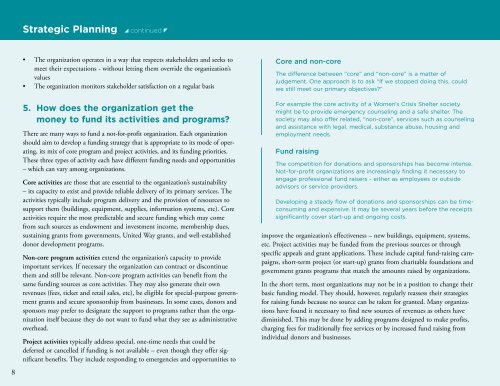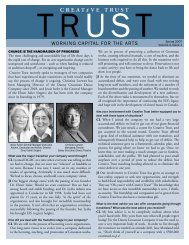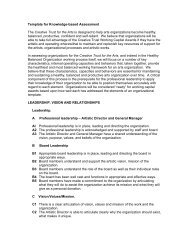20 Questions - Canadian Institute of Chartered Accountants
20 Questions - Canadian Institute of Chartered Accountants
20 Questions - Canadian Institute of Chartered Accountants
Create successful ePaper yourself
Turn your PDF publications into a flip-book with our unique Google optimized e-Paper software.
Strategic Planning y continued z<br />
8<br />
• The organization operates in a way that respects stakeholders and seeks to<br />
meet their expectations - without letting them override the organization’s<br />
values<br />
• The organization monitors stakeholder satisfaction on a regular basis<br />
5. How does the organization get the<br />
money to fund its activities and programs?<br />
There are many ways to fund a not-for-pr<strong>of</strong>it organization. Each organization<br />
should aim to develop a funding strategy that is appropriate to its mode <strong>of</strong> operating,<br />
its mix <strong>of</strong> core program and project activities, and its funding priorities.<br />
These three types <strong>of</strong> activity each have different funding needs and opportunities<br />
– which can vary among organizations.<br />
Core activities are those that are essential to the organization’s sustainability<br />
– its capacity to exist and provide reliable delivery <strong>of</strong> its primary services. The<br />
activities typically include program delivery and the provision <strong>of</strong> resources to<br />
support them (buildings, equipment, supplies, information systems, etc). Core<br />
activities require the most predictable and secure funding which may come<br />
from such sources as endowment and investment income, membership dues,<br />
sustaining grants from governments, United Way grants, and well-established<br />
donor development programs.<br />
Non-core program activities extend the organization’s capacity to provide<br />
important services. If necessary the organization can contract or discontinue<br />
them and still be relevant. Non-core program activities can benefit from the<br />
same funding sources as core activities. They may also generate their own<br />
revenues (fees, ticket and retail sales, etc), be eligible for special-purpose government<br />
grants and secure sponsorship from businesses. In some cases, donors and<br />
sponsors may prefer to designate the support to programs rather than the organization<br />
itself because they do not want to fund what they see as administrative<br />
overhead.<br />
Project activities typically address special, one-time needs that could be<br />
deferred or cancelled if funding is not available – even though they <strong>of</strong>fer significant<br />
benefits. They include responding to emergencies and opportunities to<br />
Core and non-core<br />
The difference between “core” and “non-core” is a matter <strong>of</strong><br />
judgement. One approach is to ask “If we stopped doing this, could<br />
we still meet our primary objectives?”<br />
For example the core activity <strong>of</strong> a Women’s Crisis Shelter society<br />
might be to provide emergency counseling and a safe shelter. The<br />
society may also <strong>of</strong>fer related, “non-core”, services such as counseling<br />
and assistance with legal, medical, substance abuse, housing and<br />
employment needs.<br />
Fund raising<br />
The competition for donations and sponsorships has become intense.<br />
Not-for-pr<strong>of</strong>it organizations are increasingly finding it necessary to<br />
engage pr<strong>of</strong>essional fund raisers - either as employees or outside<br />
advisors or service providers.<br />
Developing a steady flow <strong>of</strong> donations and sponsorships can be timeconsuming<br />
and expensive. It may be several years before the receipts<br />
significantly cover start-up and ongoing costs.<br />
improve the organization’s effectiveness – new buildings, equipment, systems,<br />
etc. Project activities may be funded from the previous sources or through<br />
specific appeals and grant applications. These include capital fund-raising campaigns,<br />
short-term project (or start-up) grants from charitable foundations and<br />
government grants programs that match the amounts raised by organizations.<br />
In the short term, most organizations may not be in a position to change their<br />
basic funding model. They should, however, regularly reassess their strategies<br />
for raising funds because no source can be taken for granted. Many organizations<br />
have found it necessary to find new sources <strong>of</strong> revenues as others have<br />
diminished. This may be done by adding programs designed to make pr<strong>of</strong>its,<br />
charging fees for traditionally free services or by increased fund raising from<br />
individual donors and businesses.












